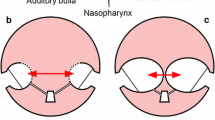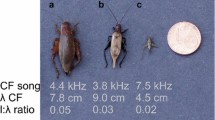Abstract
Lizard ears are coupled across the pharynx, and are very directional. In consequence all auditory responses should be directional, without a requirement for computation of sound source location. Crocodilian ears are connected through sinuses, and thus less tightly coupled. Coupling may improve the processing of low-frequency directional signals, while higher frequency signals appear to be progressively uncoupled. In both lizards and crocodilians, the increased directionality of the coupled ears leads to an effectively larger head and larger physiological range of ITDs. This increased physiological range is reviewed in the light of current theories of sound localization.







Similar content being viewed by others
References
Batra R, Yin TCT (2004) Cross correlation by neurons of the medial superior olive: a reexamination. JARO 5:238–252. doi:10.1007/s10162-004-4027-4
Beach FA (1944) Responses of captive alligators to auditory stimulation. Am Nat 78:481–505
Bierman HS, Carr CE (2015) Sound localization in the alligator. Hear Res. doi:10.1016/j.heares.2015.05.009
Bierman HS, Thornton JL, Jones HG et al (2014) Biophysics of directional hearing in the American alligator (Alligator mississippiensis). J Exp Biol 217:1094–1107. doi:10.1242/jeb.092866
Burger RM, Rubel EW (2008) Encoding of interaural timing for binaural hearing. Senses Compr Ref 3:613–630
Calford M, Piddington R (1988) Avian interaural canal enhances interaural delay. J Comp Physiol A 162:503–510
Carr CE (1993) Processing of temporal information in the brain. Annu Rev Neurosci 16:223–243. doi:10.1146/annurev.ne.16.030193.001255
Carr CE, Köppl C (2004) Coding interaural time differences at low best frequencies in the barn owl. J Physiol Paris 98:99–112. doi:10.1016/j.jphysparis.2004.03.003
Carr CE, Soares D (2002) Evolutionary convergence and shared computational principles in the auditory system. Brain Behav Evol 59:294–311
Carr CE, Soares D (2006) Shared and convergent features of the auditory system of vertebrates. In: Kaas J (ed) Evolutionary neuroscience. Academic Press, Cambridge, MA, USA, pp 479–494
Carr CE, Soares D, Smolders J, Simon JZ (2009) Detection of interaural time differences in the alligator. J Neurosci 29:7978–7990. doi:10.1523/JNEUROSCI.6154-08.2009
Christensen-Dalsgaard J (2005) Directional hearing in nonmammalian tetrapods. Sound Source Localiz. doi:10.1007/0-387-28863-5
Christensen-Dalsgaard J, Carr CE (2011) Directionality of gecko auditory nerve fibers with free field stimulation. Assoc Res Otolaryngol Abstr 34:155
Christensen-Dalsgaard J, Manley GA (2005) Directionality of the lizard ear. J Exp Biol 208:1209–1217. doi:10.1242/jeb.01511
Christensen-Dalsgaard J, Manley GA (2008) Acoustical coupling of lizard eardrums. JARO 9:407–416. doi:10.1007/s10162-008-0130-2
Christensen-Dalsgaard J, Tang Y-Z, Carr CE (2011) Binaural processing by the gecko auditory periphery. J Neurophys 105:1992–2004. doi:10.1152/jn.00004.2011
Clark JM, Norell MA, Rowe T (2002) Cranial anatomy of Citipati osmolskae (Theropoda, Oviraptorosauria), and a reinterpretation of the holotype of Oviraptor philoceratops. Am Mus Novi 3364:1–24
Coles R, Lewis DB, Hill KG et al (1980) Directional hearing in the Japanese quail (Coturnix Coturnix japonica) II. Cochlear physiology. J Exp Biol 86:153–170
Dufeau DL, Witmer LM (2015) Ontogeny of the middle-ear air-sinus system in Alligator mississippiensis (Archosauria: Crocodylia). PLoS ONE. 10(9):e0137060. doi:10.1371/journal.pone.0137060
Düring M, Karduck A, Richter H-G (1974) The fine structure of the inner ear in Caiman crocodilus. Anat Embryol 145:41–65. doi:10.1007/BF00519125
Fischer BJ, Pena JL (2009) Bilateral matching of frequency tuning in neural cross-correlators of the owl. Biol Cybern 100:521–531. doi:10.1007/s00422-009-0312-y
Fletcher NH (1992) Acoustic systems in biology. Oxford University Press, Oxford, UK
Gans E, Willis KL, Carr CE (2012) The interaural canal of the barn owl, Tyto alba. Soc Integr Comp Biol Abstr P3:147
Gleich O, Manley GA (2000) The hearing organ of birds and crocodilia. Comparative hearing: birds and reptiles. Springer, New York, pp 70–138
Green RE, Braun EL, Armstrong J et al (2014) Three crocodilian genomes reveal ancestral patterns of evolution among archosaurs. Science 346:1254449. doi:10.1126/science.1254449
Grothe B, Carr CE, Casseday J et al (2004) The evolution of central pathways and their neural processing patterns. In: Popper AN, Fay RR, Manley GA (eds) Evolution of the vertebrate auditory system. Springer, New York, pp 289–359
Grothe B, Pecka M, McAlpine D (2010) Mechanisms of sound localization in mammals. Physiol Rev 90:983–1012. doi:10.1152/physrev.00026.2009
Harper NS, McAlpine D (2004) Optimal neural population coding of an auditory spatial cue. Nature 430:682–686. doi:10.1038/nature02768
Harper NS, Scott BH, Semple MN, McAlpine D (2014) The neural code for auditory space depends on sound frequency and head size in an optimal manner. PLoS One 9(11):e108154. doi:10.1371/journal.pone.0108154
Higgs DM, Brittan-Powell EF, Soares D et al (2002) Amphibious auditory responses of the American alligator (Alligator mississipiensis). J Comp Physiol Psychol 188:217–223. doi:10.1007/s00359-002-0296-8
Hill KG, Stange G, Mo J (1989) Temporal synchronization in the primary auditory response in the pigeon. Hear Res 39:63–73
Hyson RL, Overholt EM, Lippe WR (1994) Cochlear microphonic measurements of interaural time differences in the chick. Hear Res 81:109–118
Klinke R, Pause M (1980) Discharge properties of primary auditory fibres in Caiman crocodilus: comparisons and contrasts to the mammalian auditory nerve. Exp Brain Res 38:137–150
Klump GM (2000) Sound localization in birds. In: Popper AN, Fay RR (eds) Comparative hearing birds and reptiles. Springer, Berlin
Konishi M (2003) Coding of auditory space. Annu Rev Neurosci 26:31–55. doi:10.1146/annurev.neuro.26.041002.131123
Köppl C (1997) Phase locking to high frequencies in the auditory nerve and cochlear nucleus magnocellularis of the barn owl, Tyto alba. J Neurosci 17:3312–3321
Köppl C, Carr CE (2008) Maps of interaural time difference in the chicken’s brainstem nucleus laminaris. Biol Cybern 98:541–559. doi:10.1007/s00422-008-0220-6
Kundrát M, Janáček J (2007) Cranial pneumatization and auditory perceptions of the oviraptorid dinosaur Conchoraptor gracilis (Theropoda, Maniraptora) from the Late Cretaceous of Mongolia. Naturwissenschaften 94:769–778
Larsen ON, Dooling RJ, Ryals BM (1992) Roles of intracranial air pressure in bird audition. Diversity in auditory mechanics. World Scientific, Singapore, pp 11–17
Larsen ON, Christensen-Dalsgaard J, Jensen KK (2016) Role of intracranial cavities in avian directional hearing. Biol Cybern. doi:10.1007/s00422-016-0688-4
Leake PA (1974) Central projections of the statoacoustic nerve in Caiman crocodilus. Brain Behav Evol 10:170–196. doi:10.1159/000124311
Lee M, Cau A, Naish D, Dyke GJ (2014) Sustained miniaturization and anatomical innovation in the dinosaurian ancestors of birds. Science 345:558–562. doi:10.1126/science.1240064
Manley GA (1970) Frequency sensitivity of auditory neurons in the caiman cochlear nucleus. Zeitschrift für vergleichende Physiologie 66:251–256
Manley GA (1981) A review of the auditory physiology of reptiles. Prog Sens Physiol 2:49–134
Mason MJ (2016) Internally coupled ears in living mammals. Biol Cybern. doi:10.1007/s00422-015-0675-1
McAlpine D, Grothe B (2003) Sound localization and delay lines-do mammals fit the model? Trends Neurosci 26:347–350. doi:10.1016/S0166-2236(03)00140-1
Michelsen A, Larsen ON (2008) Pressure difference receiving ears. Bioinspir Biomim 3:11001
Owen R (1843) On the communications between the Tympanum and Palate in the crocodilian reptiles. Abstracts of the Papers Communicated to the Royal Society of London, vol 5. The Royal Society, UK, pp 927–928
Palanca-Castan N, Köppl C (2015a) In vivo recordings from low-frequency nucleus laminaris in the barn owl. Brain Behav evol 85(4):271–286
Palanca-Castan N, Köppl C (2015) Change in the coding of interaural time difference along the tonotopic axis of the chicken nucleus laminaris. Front Neural Circuits 9:43. doi:10.3389/fncir.2015.00043
Rosowski JJ, Saunders JC (1980) Sound transmission through the avian interaural pathways. J Comp Physiol Psychol 136:183–190. doi:10.1007/BF00657532
Saunders JC, Duncan RK, Doan DE, Werner YL (2000) The middle ear of reptiles and birds. In: Dooling RJ, Fay RR, Popper AN (eds) Comparative hearing: birds and reptiles. Springer, Berlin, pp 70–138
Shaikh D, Hallam J, Christensen-Dalsgaard J (2016) From “ear” to there a review of biorobotic models of auditory processing in lizards. Biol Cybern. doi:10.1007/s00422-016-0701-y
Starck JM (1994) Comparative anatomy of the external and middle ear of palaeognathous birds. Adv Anat Embryol Cell Biol 131:1–137
Strain GM, Tucker TA, Graham MC, O’Malley NA (1987) Brain-stem auditory evoked potentials in the alligator. Effects of temperature and hypoxia. Electroencephalogr Clin Neurophysiol 67:68–76
Tang Y-Z, Christensen-Dalsgaard J, Carr CE (2012) Organization of the auditory brainstem in a lizard, Gekko gecko. I. Auditory nerve, cochlear nuclei, and superior olivary nuclei. J Comp Neurol 520:1784–1799. doi:10.1002/cne.23013
Vedurmudi AP, Goulet J, Christensen-Dalsgaard J, Young BA, Williams R, van Hemmen JL (2016a) How internally coupled ears generate temporal and amplitude cues for sound localization. Phys Rev Lett 116(2):028101
Vedurmudi AP, Young BA, van Hemmen JL (2016b) Internally coupled ears: mathematical structures and mechanisms underlying ICE. Biol Cybern. doi:10.1007/s00422-016-0696-4
Vossen C, Christensen-Dalsgaard J, van Hemmen JL (2010) Analytical model of internally coupled ears. J Acoust Soc Am 128:909–918. doi:10.1121/1.3455853
Werner YL, Montgomery LG, Seifan M, Saunders JC (2008) Effects of age and size in the ears of gekkotan lizards: auditory sensitivity, its determinants, and new insights into tetrapod middle-ear function. Pflugers Arch 456:951–967. doi:10.1007/s00424-008-0462-0
Werner YL, Wever EG (1972) The function of the middle ear in lizards: Gekko gecko and Eublepharis macularius (Gekkonoidea). J Exp Zool 179:1–16. doi:10.1002/jez.1401790102
Wever EG (1978) The reptile ear: its structure and function. Princeton University Press, Princeton
Witmer LM, Ridgely R, Dufeau D, Semones M (2008) Using CT to peer into the past: 3D visualization of the brain and ear regions of birds, crocodiles, and nonavian dinosaurs. In: Endo H, Frey R (eds) Anatomical imaging: towards a new morphology. Springer, Tokyo, pp 67–88
Witmer LM, Ridgely RC (2008) The paranasal air sinuses of predatory and armored dinosaurs (archosauria: theropoda and ankylosauria) and their contribution to cephalic structure. Anat Rec 291:1362–1388. doi:10.1002/ar.20794
Witmer LM, Ridgely RC (2009) New insights into the brain, braincase, and ear region of tyrannosaurs (Dinosauria, Theropoda), with implications for sensory organization and behavior. Anat Rec 292:1266–1296. doi:10.1002/ar.20983
Yan K, Tang Y-Z, Carr CE (2010) Calcium-binding protein immunoreactivity characterizes the auditory system of Gekko gecko. J Comp Neurol 518:3409–3426. doi:10.1002/cne.22428
Zhang G, Jarvis ED, Gilbert MTP (2014) Avian genomes. A flock of genomes. Introduction. Science 346:1308–1309. doi:10.1126/science.346.6215.1308
Acknowledgments
We gratefully acknowledge the assistance of J. Matthews with the computation of Fisher information statistics. This research was sponsored by the National Institute on Deafness and Other Communications Disorders (NIDCD) Grant DC-000436 (CEC) and by the Danish Natural Science Research Council (J.C-D)
Author information
Authors and Affiliations
Corresponding author
Additional information
This article belongs to a Special Issue on Internally Coupled Ears (ICE).
Rights and permissions
About this article
Cite this article
Carr, C.E., Christensen-Dalsgaard, J. & Bierman, H. Coupled ears in lizards and crocodilians. Biol Cybern 110, 291–302 (2016). https://doi.org/10.1007/s00422-016-0698-2
Received:
Accepted:
Published:
Issue Date:
DOI: https://doi.org/10.1007/s00422-016-0698-2




